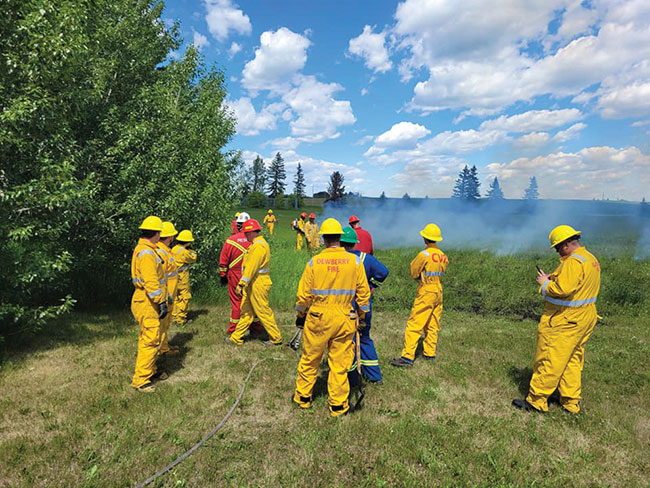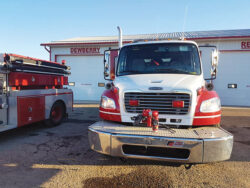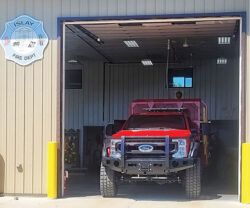
Features
Wildfire Week
Wildfire fighting: Outside the realm of traditional
The evolving scope of wildfire fighting in Canada
March 30, 2023
By Kirk Hughes
 Brush trucks provide more reach than traditional fire apparatus, with off-road capacity and grit needed in remote terrain.
ALL PhotoS: Kirk Hughes
Brush trucks provide more reach than traditional fire apparatus, with off-road capacity and grit needed in remote terrain.
ALL PhotoS: Kirk Hughes The Floor is Lava! is a fun, non-sensical game that has little rules and only one main goal: when the time is up, you can’t have any part of your body touching the floor. An odd euphemism, but an accurate one to describe the changing roles of the fire service in the first quarter of the new millennium.
Looking back at the growth, expansion, and changes of firefighter roles since the end of World War II, it is remarkable how the job description and expectations placed on firefighters has been altered, and it is no surprise that significant events around the globe are placing additional tasks on the plates of our first responders.
Just like the scramble to get feet off the floor, the fire service is increasingly being asked to take on more (often to fill gaps) and prepare for and respond to a multitude of hazards facing our society. Recent fires like Fort McMurray, Slave Lake and Lytton have shown us that the threat of wildland-urban interface fires is yet another wave of lava that the fire service is being asked to stem the flow of by going outside of the accustomed traditional models and adapting a new philosophy of modern integration between equipment, training, and tactics.
There once was a time where a clear separation existed between the roles of wildland firefighter and municipal departments. Other than the odd brush or stubble fire, forest fires were the domain of speciality crews, often funded by the provincial government.
As the years passed, and funding dwindled, the task was partitioned out, and often pieces placed at the feet of firefighters who, other than a brief blurb in their training, had minimal experience dealing with the chaotic challenges associated with wildfires. Those days have long since passed, and now the municipal firefighter, once only worried about structural attacks and vehicle fires, is part and parcel of a larger response to the growing threat of community wildfires.
Addressing the transition includes an assessment of current and future equipment. Most urban and rural fire departments have some capacity to tackle wildfires, seeing as even the most urbanized stations have some green spaces that require protection, but few have any advance capacity.
A prime candidate for improving wildfire capability lays with the development of select features in apparatus. Newer trucks coming into service, some customized to specifically address the wildfire threat, include some interesting features that are a direct result of innovation and lessons learned. The booster reel, once a staple in the past, has made a come-back as crews have seen the value of utilizing lightweight and flexible lines during brush fires.
A more recent adaption has been the remote operated front bumper turret, a combination nozzle that allows the driver to operate a line from the safety, and comfort, of the interior cab. This not only aids in a mobile approach to fighting fires, but it also reduces the number of firefighters needed to operate it, which makes a significant impact during long duration fires, especially while short staffed.
Even the configuration of some fire apparatuses are being considered when determining the purpose of newer fleet additions, particularly if the department is moving towards a hybrid fleet of structural and wildfire.

Front-mounted nozzle turret adaption added on to traditional Type 1 engines and provide additional power when battling wildfires.
The introduction of “brush trucks”, or mini pumpers, for example, has altered the response capabilities of departments that once relied solely on the use of larger engines and tenders. These smaller, more robust trucks, allow for more freedom of movement, off-road capabilities, while still packing a deadly enough punch to subdue stubborn fires in hard to reach locations.
A department that is proficient in bringing those trucks to bear on outside fires will see a savings on the wear and tear of the larger trucks, not to mention their firefighters who can now be carried further into the fight in the cab of a “brush truck” then they ever could have been in a larger structural engine. As the response landscape alters, so too should the apparatus fleet grow and alter to meet the shifting changes.
As much as equipment makes a major impact on how any fire is confronted, nothing can prepare firefighters for new realities better than training. Firefighters who are tasked to fight wildfires can now expand their skill sets beyond the training initially taught in the NFPA 1001 Level 1 program.
Advanced courses in Wildland Firefighting (NFPA 1051), specialized urban interface training and even disciplines dealing with weather, fire behaviour and aerial operations are key. The amount of information and knowledge available in the field is incredible, and generally easy to access.
Even training at the station level has greatly improved and is aimed at the hybrid role most fire departments experience between structural and brush calls. Local training can expand on the basics, which can cross over between the skills needed for many types of calls, or, since most provinces have links additional training related to forest fires, incorporating those curriculums into regular training nights can really enhance the abilities of firefighters working the fire lines.
Making time to address the unique skills required for battling wildfires, such as fire breaks and chainsaw work, is the best method to better prepare for wildland season.
Even with modified equipment and better training, the average fire officer needs to have a strong understanding of tactics and strategy when working wildfires. Although a lot of the same processes exist in municipal firefighting, the demanding nature of wildfires differs and presents exclusive problems that an incident commander has to be prepared to deal with.
Ideally, a community has done its part and completed a series of fire smarting activities, such as removing dead trees or long dry grass. There are programs that exist within Canada to aid homeowners in preparing their homes from this growing threat.
Even with a preparation mindset, fires happen, and that is when any proactive planning pays off. A recommendation from the “lessons learned” category of wildfires is the research and adoption of a wildland urban interface plan. Not unlike a tactical plan, this document is a rough guideline designed to provide front-line leaders with initial reflex tasking ideas to enable them to better assess, handle, extinguish and ultimately defeat wildfires.
Certainly, no plan survives first-contact, but having an idea of how to assess the fire’s behaviour, coupled with factors such as topography and weather, provide sound tactical advice in order to better deploy and manage assets during an incident.

Training doesn’t have to be elaborate, and can incorporate routines used in structural firefighting. The goal is to be familiar with the tools in preparation for the next wildfire call.
Again, the goal isn’t to have step by step directions, but rather provide insights that may assist the incident commander in making solid fire ground decisions during the initial stages of a conflagration. The creation of this plan doesn’t have to be overly complicated. It can boil down to a simple checklist or be as intricate as any other standing operating procedure. Again, the goal is to incorporate the unique mindset required when fighting wildfires with the existing skill sets of municipally trained firefighters.
As our climate adapts, so too must the fire service, and nowhere is this more evident than when dealing with wildfires.
High profile events aside, the amount of wildland calls is increasing, and with drier conditions being reported across the country, and fire behaviour showing more and more aggression than past years, being ready to handle these types of incidents is becoming a critical component for firefighters.
Making alterations to equipment specific to fighting wildfires or purchasing apparatus specific for the task are keen investments, and when tethered to regular and advanced training, can really make a difference on the fire ground.
Add in an ounce of prevention through fire smarting and pre-planning, and the tools available to the department to battle against wildfires increase the odds of success. Afterall, the key term here is readiness, to anticipate, and respond to, any wildfire situation. This may seem like a very vague mission statement, and it is purposely designed that way, thus allowing a fire department the ability to bend in the direction that needs to be taken without breaking from this additional pressure.
It all boils down to one key phrase when dealing with the wildfires: be prepared, because you’ve got about three seconds before the floor becomes lava and rumour has it, there are dinosaurs on the chairs.
Kirk Hughes is the Director of Protective Services for the County of Vermilion River (Alberta) and a recent panelist for the Fire Fighting in Canada 2022 Virtual Summit on Climate Change. During the summer of 2017, Chief Hughes was assigned as a Task Force Commander to protect the Waterton Townsite during the Kenow Fire. He can be reached at khughes@county24.com.
Print this page